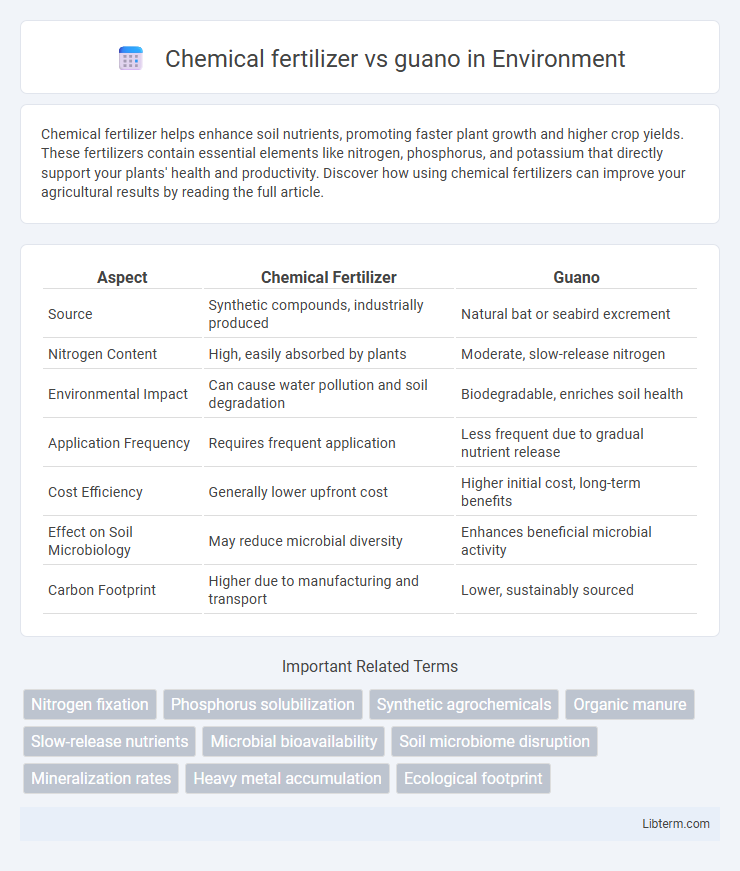Chemical fertilizer helps enhance soil nutrients, promoting faster plant growth and higher crop yields. These fertilizers contain essential elements like nitrogen, phosphorus, and potassium that directly support your plants' health and productivity. Discover how using chemical fertilizers can improve your agricultural results by reading the full article.
Table of Comparison
| Aspect | Chemical Fertilizer | Guano |
|---|---|---|
| Source | Synthetic compounds, industrially produced | Natural bat or seabird excrement |
| Nitrogen Content | High, easily absorbed by plants | Moderate, slow-release nitrogen |
| Environmental Impact | Can cause water pollution and soil degradation | Biodegradable, enriches soil health |
| Application Frequency | Requires frequent application | Less frequent due to gradual nutrient release |
| Cost Efficiency | Generally lower upfront cost | Higher initial cost, long-term benefits |
| Effect on Soil Microbiology | May reduce microbial diversity | Enhances beneficial microbial activity |
| Carbon Footprint | Higher due to manufacturing and transport | Lower, sustainably sourced |
Introduction to Chemical Fertilizer and Guano
Chemical fertilizers are synthetic substances designed to supply essential nutrients such as nitrogen, phosphorus, and potassium directly to plants, enhancing crop growth and yield. Guano, a natural organic fertilizer derived from accumulated seabird or bat excrement, is rich in nitrogen, phosphate, and trace minerals, promoting soil fertility and microbial activity. Both fertilizers play key roles in modern agriculture but differ significantly in composition, environmental impact, and nutrient release mechanisms.
Composition and Nutrient Profiles
Chemical fertilizers typically contain concentrated amounts of nitrogen, phosphorus, and potassium in precise ratios tailored for specific crops, often supplemented with secondary nutrients and micronutrients to enhance plant growth. Guano, derived from accumulated seabird or bat excrement, offers a rich, natural source of nitrogen, phosphorus, and potassium, along with trace elements and organic matter that improve soil structure and microbial activity. While chemical fertilizers provide immediate nutrient availability, guano delivers a complex nutrient profile that supports long-term soil fertility and ecosystem health.
Historical Use and Development
Chemical fertilizers emerged in the early 20th century with the Haber-Bosch process enabling mass synthetic nitrogen production, revolutionizing modern agriculture. Guano, harvested extensively in the 19th century from seabird droppings found primarily on islands off Peru, provided an early rich source of nitrogen, phosphorus, and potassium essential for crop growth. The shift from guano to chemical fertilizers marked a transition from natural organic inputs to industrially manufactured nutrients, significantly increasing global food production capacity.
Application Methods and Ease of Use
Chemical fertilizers are typically applied using precise machinery such as spreaders or sprayers, allowing for uniform distribution and controlled nutrient delivery that enhances crop yield efficiency. Guano, rich in nitrogen, phosphorus, and potassium, is often applied manually or with basic spreaders, making it suitable for small-scale or organic farming but less convenient for large commercial operations due to potential odor and irregular nutrient release. The ease of use of chemical fertilizers lies in their standardized formulation and application technology, whereas guano requires careful handling and timing to optimize soil health benefits without nutrient runoff.
Environmental Impact Comparison
Chemical fertilizers often contribute to soil degradation, water pollution, and greenhouse gas emissions due to their synthetic composition and high nutrient concentrations. Guano, as a natural organic fertilizer rich in nitrogen, phosphorus, and potassium, promotes soil health and biodiversity while minimizing environmental harm. However, excessive guano harvesting can disrupt ecosystems and marine wildlife habitats, highlighting the need for sustainable sourcing practices.
Effects on Soil Health
Chemical fertilizers provide immediate nutrient availability but often degrade soil structure and reduce microbial diversity over time. Guano, rich in organic matter and trace minerals, enhances soil fertility by promoting beneficial microorganisms and improving water retention. Long-term use of guano supports sustainable soil health, whereas chemical fertilizers may lead to nutrient imbalances and soil acidification.
Crop Yield and Quality Results
Chemical fertilizers provide immediate nutrient availability, often leading to rapid increases in crop yield, especially in large-scale agricultural operations. Guano, rich in organic matter and essential micronutrients, enhances soil health and improves long-term crop quality by promoting better texture, flavor, and nutritional content. Studies demonstrate that integrating guano can sustain yield levels while significantly boosting crop quality compared to sole reliance on chemical fertilizers.
Cost-Effectiveness and Availability
Chemical fertilizers offer high nutrient concentration and immediate availability, making them cost-effective for large-scale agricultural operations despite variable market prices and production costs. Guano, derived from accumulated seabird or bat excrement, provides organic nutrients with long-term soil health benefits but often incurs higher costs and limited availability due to regional sourcing constraints. The choice between chemical fertilizer and guano hinges on balancing upfront expenses against sustainability goals and supply chain reliability in specific farming contexts.
Health and Safety Considerations
Chemical fertilizers often contain synthetic compounds that can lead to soil degradation and water contamination, posing long-term health risks to humans and ecosystems. Guano, a natural fertilizer rich in nitrogen, phosphorus, and potassium, is generally safer but can harbor pathogens if not properly processed, requiring careful handling. Both require appropriate safety measures to minimize exposure and environmental impact, emphasizing the importance of informed application practices.
Future Trends in Fertilizer Use
Future trends in fertilizer use emphasize sustainable alternatives, with guano gaining popularity due to its rich organic nutrients and lower environmental impact compared to chemical fertilizers. Innovations in slow-release chemical formulations aim to enhance efficiency while reducing runoff and greenhouse gas emissions. Integration of precision agriculture technologies further optimizes fertilizer application, balancing nutrient supply and environmental protection.
Chemical fertilizer Infographic

 libterm.com
libterm.com